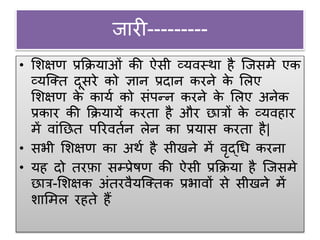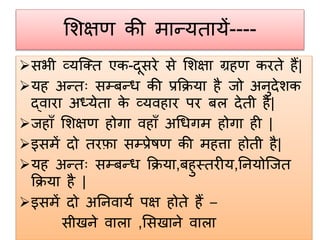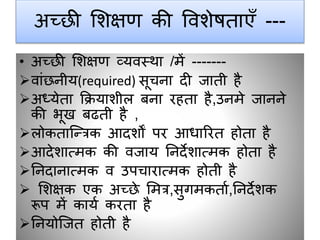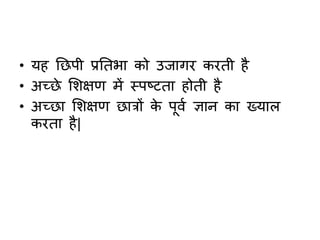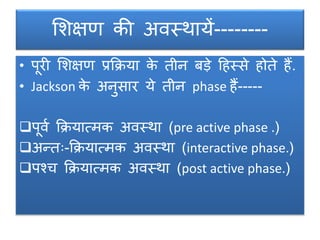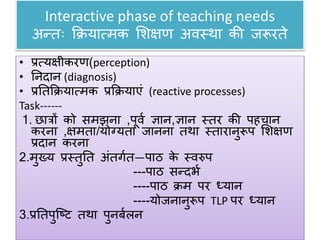शिक्षण क्या
- 1. शिक्षण क्या? • दूसरे को सीखने के शिए ददिा ननदेि देने तथा अन्य प्रकार से उन्हें ननदेशित करने की प्रक्रिया को शिक्षण कहा जाता है| • शिक्षण एक उद्देश्य ननदेशित क्रिया है जो अधिगम हेतु भूख जगानेवािा,मागगदिगक,उत्साहविगक तथा ददिाबोिक है | • ऐसी प्रक्रिया है जजसके प्रारूप एवं संचािन की व्यवस्था इसशिए की जाती है जजससे छात्रों के व्यवहारों में पररवतगन िाया जा सके |
- 2. जारी--------- • शिक्षण प्रक्रियाओं की ऐसी व्यवस्था है जजसमे एक व्यजक्त दूसरे को ज्ञान प्रदान करने के शिए शिक्षण के कायग को संपन्न करने के शिए अनेक प्रकार की क्रियायें करता है और छात्रों के व्यवहार में वांनछत पररवतगन िेन का प्रयास करता है| • सभी शिक्षण का अथग है सीखने में वृद्धि करना • यह दो तरफ़ा सम्प्प्रेषण की ऐसी प्रक्रिया है जजसमे छात्र-शिक्षक अंतरवैयजक्तक प्रभावों से सीखने में िाशमि रहते हैं
- 3. शिक्षण की मान्यतायें---- सभी व्यजक्त एक-दूसरे से शिक्षा ग्रहण करते हैं| यह अन्तः सम्प्बन्ि की प्रक्रिया है जो अनुदेिक द्वारा अध्येता के व्यवहार पर बि देती है| जहााँ शिक्षण होगा वहााँ अधिगम होगा ही | इसमें दो तरफ़ा सम्प्प्रेषण की महत्ता होती है| यह अन्तः सम्प्बन्ि क्रिया,बहुस्तरीय,ननयोजजत क्रिया है | इसमें दो अननवायग पक्ष होते हैं – सीखने वािा ,शसखाने वािा
- 4. शिक्षण की प्रकृ नत प्रभावकारी एवं व्यवजस्थत. समस्त प्रक्रियाओं का आिार मनोववज्ञान . किा एवं ववज्ञान क्रिया एवं प्रक्रिया भी सांके नतक,क्रियात्मक तथा िाजददक व्यवहार ननदहत शिक्षण कायग का अशभप्राय ज्ञान प्रदान करने व मागगदिगन से है मूितः यह कौििात्मक क्रिया है
- 5. अच्छी शिक्षण की वविेषताएाँ --- • अच्छी शिक्षण व्यवस्था /में ------- वांछनीय(required) सूचना दी जाती है अध्येता क्रियािीि बना रहता है,उनमे जानने की भूख बढती है , िोकताजन्त्रक आदिों पर आिाररत होता है आदेिात्मक की वजाय ननदेिात्मक होता है ननदानात्मक व उपचारात्मक होती है  शिक्षक एक अच्छे शमत्र,सुगमकताग,ननदेिक रूप में कायग करता है ननयोजजत होती है
- 6. • यह नछपी प्रनतभा को उजागर करती है • अच्छे शिक्षण में स्पष्टता होती है • अच्छा शिक्षण छात्रों के पूवग ज्ञान का ख्याि करता है|
- 7. शिक्षण की अवस्थायें-------- • पूरी शिक्षण प्रक्रिया के तीन बड़े दहस्से होते हैं. • Jackson के अनुसार ये तीन phase हैं----- पूवग क्रियात्मक अवस्था (pre active phase .) अन्तः-क्रियात्मक अवस्था (interactive phase.) पश्च क्रियात्मक अवस्था (post active phase.)
- 8. Pre active phase of teaching needs— पूवग क्रियात्मक शिक्षण अवस्था की जरूरते पाठ ननयोजन --- क्या पढ़ना है? क्रकतना पढ़ना है? कै से पढाना है? -ववधि -सहायक सामग्री/TLM क्या -समय प्रबंिन उक्त सभी को – दृजष्टगत करना,ननणगय िेना ,तैयारी व संगदठत करना (visualize,decision making,preparation & organization)
- 9. Interactive phase of teaching needs अन्तः क्रियात्मक शिक्षण अवस्था की जरूरते • प्रत्यक्षीकरण(perception) • ननदान (diagnosis) • प्रनतक्रियात्मक प्रक्रियाएं (reactive processes) Task------ 1. छात्रों को समझना ,पूवग ज्ञान,ज्ञान स्तर की पहचान करना ,क्षमता/योग्यता जानना तथा स्तारानुरूप शिक्षण प्रदान करना 2.मुख्य प्रस्तुनत अंतगगत—पाठ के स्वरुप ---पाठ सन्दभग ----पाठ िम पर ध्यान ----योजनानुरूप TLP पर ध्यान 3.प्रनतपुजष्ट तथा पुनबगिन
- 10. पश्च क्रियावस्था की जरूरते Post active phase of teaching needs-- • वास्तववक पररवतगनों की तुिना अपेक्षक्षत व्यवहार पररवतगन से करना • मूलयांकन की उपयुक्त प्रववधि का चयन • प्राप्त पररणाम के आिार पर पुनशिगक्षण का ननणगय िेना • उपचारात्मक शिक्षण हेतु ननणगय िे पाना

